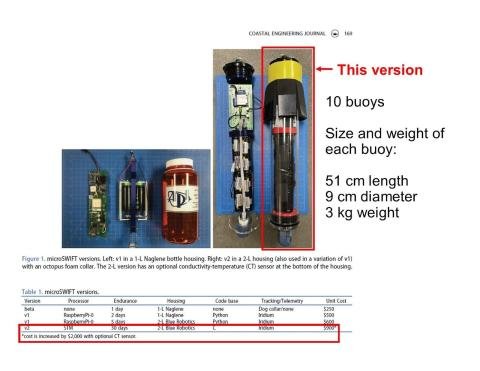microSWIFT expendable wave buoys are small, GPS-equipped floating sensors designed to measure wave and surface current data in real-time. These buoys are highly portable, inexpensive, and often used in large quantities to capture detailed oceanographic data over expansive areas. They are particularly useful in studying coastal and nearshore wave dynamics, as well as in remote or hard-to-access areas.
Key Features of microSWIFT Wave Buoys
- Compact and Lightweight: They’re designed to be very small and light, making them easy to deploy by hand from small boats, drones, or even aircraft.
- Expendable Design: While many are designed for multiple uses, microSWIFT buoys are also inexpensive enough to be used in one-time deployments, making them ideal for collecting data in locations where retrieval would be challenging or costly.
- Real-Time Data Collection: Equipped with GPS, accelerometers, and sometimes even gyroscopes, these buoys collect data on wave height, wave direction, period, and surface currents. The data is typically transmitted in real-time, allowing for immediate analysis.
- GPS-Based Wave Measurement: Using GPS, the buoy tracks its position as it moves with the waves, allowing it to measure wave height and direction by observing its vertical and horizontal displacement over time.
- Deployment Versatility: microSWIFT buoys can be deployed in various environments, from calm coastal areas to more turbulent offshore zones, providing valuable insights for applications in marine science, coastal engineering, and environmental monitoring.
Applications of microSWIFT Wave Buoys
- Coastal Monitoring: Tracking changes in wave patterns near shorelines for studying erosion, sediment transport, and wave impacts.
- Disaster Response: Providing real-time data on waves and currents during hurricanes, tsunamis, and storm surges.
- Renewable Energy Research: Measuring wave patterns for offshore wind farms or wave energy projects to optimize power generation.
- Environmental Research: Studying wave climates and surface currents to understand the effects of climate change on coastal and marine ecosystems.
By offering a low-cost, easily deployable, and reliable means of capturing wave data, microSWIFT buoys play a crucial role in advancing oceanographic research and coastal management practices.

